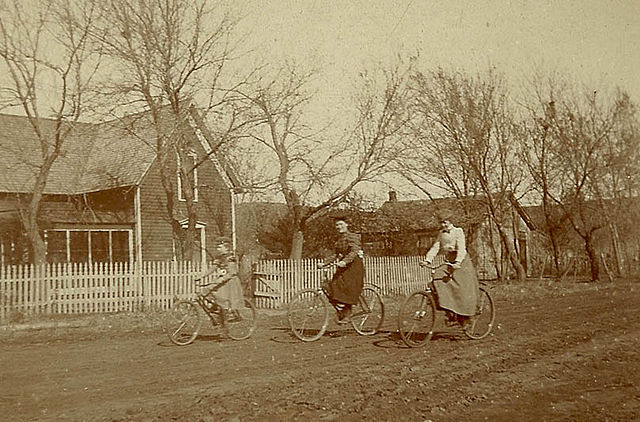The Made-Up Malady to Get Women Off of Bicycles
“Don’t scream if you meet a cow. If she sees you first, she will run.”
“Don’t undertake a long ride if you are not confident of performing it easily.”
“Don’t contest the right of way with cable cars.”
“Don’t emulate your brother’s attitude if he rides parallel with the ground.”
Those four “don’t” are from the now-defunct New York World newspaper. Originally published in 1895, the list of 41 “don’t” (available via the wonderful Brain Pickings blog) are suggestions for bicyclists, and if the four above are any indication, the advice isn’t terrible and applies to everyone. Unfortunately for our retroactive view into history, the rest of the advice isn’t so innocuous. The list is actually intended specifically for female bicyclists, and contains some sexist gems which have nothing to do with safety:
“Don’t chew gum. Exercise your jaws in private.”
“Don’t ignore the laws of the road because you are a woman.”
“Don’t use bicycle slang. Leave that to the boys.”
“Don’t go without a needle, thread and thimble.”
And that’s just a taste. You really should check out the whole list — it’s a fascinating (and, anachronistically, troubling) look into the culture of a century-plus ago. And when you do read the whole list, you may notice one very odd rule:
“Don’t cultivate a ‘bicycle face.’”
What’s that mean? Effectively, it means “don’t bicycle too much, or you might fall ill.” And it’s a lie — one designed to keep women in the home.

The bicycle as we know it was invented in the mid-1800s and improved regularly over the decades after. By the close of the 19th century, bicycling was a craze all to itself. And for women in particular, the bicycle was more than just a diversion — it was a path to freedom. As discussed in another Brain PIckings post, the bicycle allowed women to travel freely and unchaperoned — one could simply get on a bike and go. Further, because of the physical requirements of the contraption, women were able to wear less restrictive clothing while bicycling. (We’re not talking about bikinis, though; the change was from huge, restrictive dresses to still-formal, but slightly less restrictive bicycling suits.) In 1896, famed equal rights advocate Susan B. Anthony sang the praises of the bicycle: “Let me tell you what I think of bicycling. I think it has done more to emancipate women than anything else in the world. I stand and rejoice every time I see a woman ride by on a wheel.”
And, unfortunately, many men agreed — but saw the bicycle as a threat. As a result, some began a PR campaign to stop women from taking up the two-wheeled contraptions. Part of that was “bicycle face,” a disease which was first floated in a National Review (London) article from 1895, under the title “The Hidden Dangers of Cycling.” As Vox explains, bicycle face was one of the major maladies that could afflict women who spend too long behind the handlebars:
“Over-exertion, the upright position on the wheel, and the unconscious effort to maintain one’s balance tend to produce a wearied and exhausted ‘bicycle face,'” noted the Literary Digest in 1895. It went on to describe the condition: “usually flushed, but sometimes pale, often with lips more or less drawn, and the beginning of dark shadows under the eyes, and always with an expression of weariness.” Elsewhere, others said the condition was “characterized by a hard, clenched jaw and bulging eyes.”
All best avoided if you’re a 1890s homemaker — or hoping to become one.
Of course, cycling isn’t unhealthy — the opposite, in fact — and within a few years, other doctors began to debunk the risk of bicycle face and extoll the health virtues of taking up bicycling. The term lasted through the turn of the century and into the 1920s, but to date, there are no known fatalities from the fictional disease.
 Bonus Fact: According to NKNews.org (“an independent, privately owned specialist site focused on North Korea”), bicycles were banned in North Korea until 1992 — and women still can’t legally ride them. The no-female-cyclists ban has been mostly ignored since 2013, though.
Bonus Fact: According to NKNews.org (“an independent, privately owned specialist site focused on North Korea”), bicycles were banned in North Korea until 1992 — and women still can’t legally ride them. The no-female-cyclists ban has been mostly ignored since 2013, though.
From the Archives: Slow and Unsteady Wins the Sprint: If you’ve never seen a bicycle sprint, you need to watch the video and read the explanation as to what just happened.
Take the Quiz: Name the nations with the most bicycles per capita. Hint: North Korea isn’t one of them.
Related: Jumbo-faced Bicycles.
